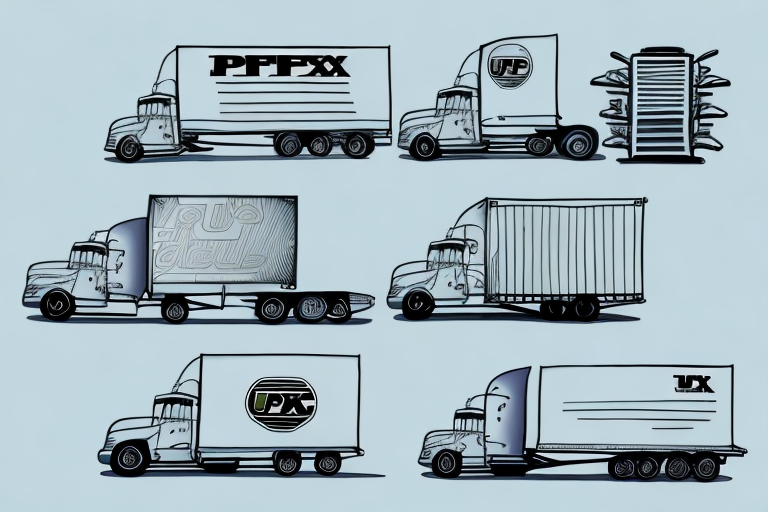Comparing UPS and FedEx Rates for Shipping Options
If you own or manage a business, you know that shipping is a crucial aspect to consider. Choosing the right shipping carrier can significantly impact your operational efficiency and customer satisfaction. Two of the most popular options available are UPS and FedEx. In this article, we will compare and contrast the rates and shipping options offered by both companies, providing an in-depth analysis to help you make an informed decision. Let's dive in!
Introduction to UPS and FedEx Shipping Services
UPS and FedEx are both well-known shipping companies that offer a wide variety of shipping options. Both companies provide reliable and efficient service to customers globally, maintaining high levels of customer satisfaction through quality service and timely deliveries.
One of the key differences between UPS and FedEx is their approach to package delivery. UPS typically focuses on ground transportation, leveraging its extensive logistics network to offer cost-effective solutions. In contrast, FedEx offers a broader range of delivery options, including air and ground transportation, catering to customers who require faster delivery times. According to the 2023 FedEx Service Guide, FedEx handles over 15 million packages daily, highlighting its capabilities in expedited shipping.
Understanding Shipping Rates and Fees
Before comparing the specific rates of each carrier, it's crucial to understand how shipping rates and fees work. Most shipping carriers like UPS and FedEx charge based on the size, weight, shipping distance, and delivery time required. Essentially, the more you ship, the more you will pay. Shipping rates fluctuate frequently due to factors such as fuel costs and regulatory standards. According to the UPS Sustainability Report 2023, fuel surcharges account for approximately 15% of total shipping costs.
Additionally, shipping rates can vary depending on the type of item being shipped. For example, hazardous materials or fragile items may require special handling and packaging, resulting in higher shipping fees. Both carriers may offer discounts for certain types of shipments or for customers who ship frequently. It's always advisable to research and compare rates from different carriers to ensure you are getting the best deal for your specific shipping needs.
Factors Affecting Shipping Costs
Several factors can influence the cost of shipping. Key factors include:
- Distance Shipped: Longer distances generally incur higher shipping costs.
- Package Size and Weight: Larger and heavier packages cost more to ship.
- Delivery Time: Faster delivery options come at a premium.
- Destination: International shipments or areas with challenging logistics can increase costs.
- Mode of Transportation: Shipping by air is typically more expensive than by sea or land.
For example, shipping a 10-pound package from New York to Los Angeles via air may cost significantly more than shipping the same package via ground. Additionally, international shipments may face customs fees and import taxes, further affecting the total cost.
How to Calculate Shipping Rates for UPS and FedEx
Both UPS and FedEx offer user-friendly tools to calculate shipping rates based on the weight, size, and destination of your package. You can use their respective websites or contact customer service for assistance:
When calculating shipping rates, consider any additional fees that may apply, such as:
- Signature confirmation
- Insurance
- Saturday delivery
Both carriers offer various services that can increase the overall shipping cost. Additionally, the shipping speed plays a crucial role in determining the cost. Faster shipping options, like overnight delivery, typically come with a higher price tag.
Comparison of Domestic and International Shipping Rates
UPS and FedEx approach domestic and international shipping differently. FedEx has a strong focus on overseas shipping markets, leveraging its global network to provide competitive international rates. Conversely, UPS has a more established infrastructure within the United States, offering robust domestic shipping solutions.
For domestic shipments, both carriers have similar pricing structures. However, FedEx often offers more affordable rates for international shipping, especially for heavier or larger packages. According to the UPS International Shipping Guide, UPS provides comprehensive services with reliable delivery times and advanced tracking options for international shipments.
The type of package being shipped also affects pricing. For instance, shipping a small package domestically with UPS may be more cost-effective, while a large international package might be cheaper with FedEx due to their established foreign presence and partnerships with local carriers.
Comparison of Ground and Air Shipping Rates
Both UPS and FedEx offer various shipping options based on delivery speed:
- Ground Shipping: More cost-effective for larger and heavier packages, with longer delivery times.
- Air Shipping: Faster delivery for smaller and lighter packages, but at a higher cost.
The choice between ground and air shipping should consider both the weight and size of your shipment, as well as any potential shipping restrictions. For example, hazardous materials may be restricted from air shipping due to safety regulations.
Comparison of Standard and Expedited Shipping Rates
Deciding between standard and expedited shipping options involves evaluating the trade-off between cost and delivery speed:
- Standard Shipping: More affordable, suitable for non-urgent deliveries, with longer delivery timeframes.
- Expedited Shipping: Higher cost, ideal for time-sensitive packages, with guaranteed faster delivery times.
Additionally, expedited shipping often includes more comprehensive tracking and insurance options, providing added security for valuable or fragile items.
Comparison of Residential and Commercial Shipping Rates
The destination type—residential or commercial—can impact shipping rates. Both UPS and FedEx charge different rates based on the delivery address:
- Commercial Addresses: Typically, shipping to business addresses can be more cost-effective. For instance, if you frequently ship to businesses, UPS may offer volume discounts that result in lower overall costs.
- Residential Addresses: FedEx may be more advantageous, offering flexible delivery options such as evening and weekend deliveries. UPS may charge additional fees for residential deliveries or require recipients to pick up packages from local UPS locations.
Delivery Timeframes for UPS and FedEx Shipping Services
Both UPS and FedEx provide a range of delivery timeframes to meet different shipping needs:
- Same-Day Delivery: Available for urgent shipments, typically at a premium cost.
- Next-Day Delivery: Ensures packages arrive the following day, suitable for most urgent needs.
- Two-Day Delivery: Balances cost and speed, ideal for non-extreme urgent deliveries.
- Ground Shipping: Cost-effective for non-urgent deliveries, with longer delivery times.
Both carriers provide estimated delivery dates and real-time tracking information to help you plan and monitor your shipments effectively.
Tracking Packages with UPS and FedEx
Tracking is a vital feature offered by both UPS and FedEx, allowing customers to monitor their packages throughout the delivery process. Tracking information typically includes the current location of the package, delivery estimates, and proof of delivery.
Customers can access tracking information via the UPS and FedEx websites or their mobile apps. Additional features include:
- Delivery alerts and notifications
- Options to request delivery changes
- Authorization for package release without a signature
These features enhance convenience and provide flexibility, ensuring that packages are delivered according to the recipient's availability.
Insurance Options for UPS and FedEx Shipments
Both UPS and FedEx offer insurance options to protect the value of your shipments. Customers can select the level of insurance based on the package's value:
- Basic insurance covers the value of the package up to a certain limit.
- Additional insurance can be purchased for high-value items.
It's important to note that insurance typically only covers the value of the package itself, not any additional costs incurred due to delays or lost shipments. Therefore, consider purchasing additional insurance or opting for a shipping method that includes more comprehensive coverage.
Proper packaging and labeling are essential to ensure eligibility for insurance coverage. Both carriers have specific guidelines, and failing to adhere to these can result in denied insurance claims.
Discounts Available for UPS and FedEx Customers
both UPS and FedEx offer a variety of discounts to help businesses reduce shipping costs:
- Volume Discounts: Lower rates for shipping larger volumes of packages.
- Loyalty Discounts: Special rates for long-term customers.
- Promotional Discounts: Limited-time offers and seasonal promotions.
- Contract Pricing: Customized pricing plans based on specific business needs.
Evaluating and leveraging these discounts can result in significant savings, especially for businesses with high shipping volumes.
Customer Service Offered by UPS and FedEx
Excellent customer service is crucial when selecting a shipping carrier. Both UPS and FedEx provide responsive customer service departments to assist with any questions or concerns during the shipping process:
- 24/7 Support: Access to customer service representatives around the clock.
- Multiple Contact Channels: Support via phone, email, and live chat.
- Comprehensive Online Resources: Detailed FAQs, shipping guides, and troubleshooting tips available on their websites.
Positive customer service experiences can enhance your overall satisfaction with the shipping process and resolve any issues promptly.
Conclusion: Which Carrier is Best for Your Business?
Both UPS and FedEx offer extensive advantages in shipping services, and choosing the right one ultimately depends on your business's individual needs. Consider the following factors when making your decision:
- Shipping Volume: Higher volumes may benefit from volume discounts.
- Delivery Location: Domestic versus international shipping needs.
- Shipping Time Requirements: Urgent deliveries may necessitate expedited options.
- Package Characteristics: Size, weight, and type of items being shipped.
- Budget Constraints: Balancing cost with required services.
By carefully evaluating these factors and utilizing the tools and discounts offered by each carrier, you can select the most cost-effective and reliable shipping solution for your business needs. Making the right choice can save you money and provide peace of mind for all your future shipping requirements.




















